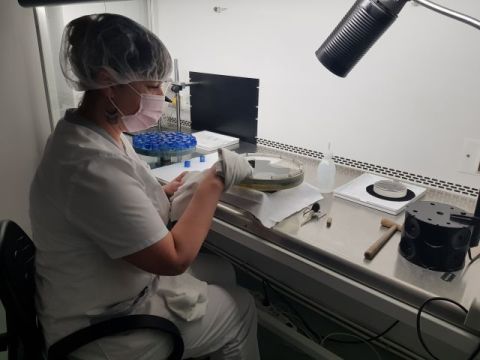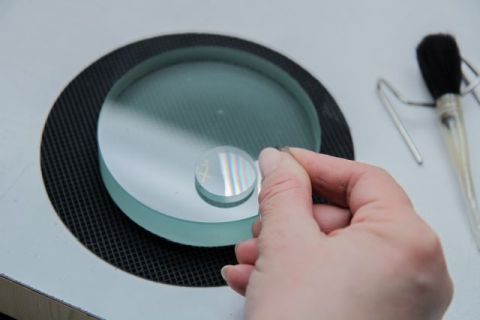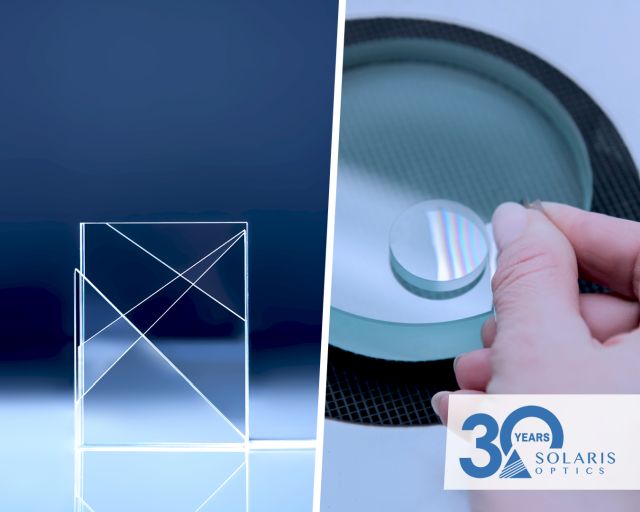Optical Contact Bonding Capabilities in Solaris Optics
Published: January 31, 2022
Optical contact bonding is a technique, in which two optical elements are joined with no additional bonding component, in particular – no chemical adhesives. The bonding process takes place on a molecular level.
In the following article we describe the capabilities and limits of optical contact bonding in Solaris Optics. Before we go further, for the readers who have not read our publication on optical bonding, a brief reminder.
There are several significant advantages related to the lack of adhesive in element bonding, including:
- cleanliness of the bonded optical element; for applications in vacuum environments such adhesives can e.g. contaminate the optical surfaces, whereas with contact bonding such issues disappear;
- no additional refractive index along the optical path; this is advantageous for instance in some demanding measurement applications. With a proper material selection (e.g. glasses from the same melt) a bonded component performs optically almost like a single optical component (although typically some reflections may occur).
Contact Bonding in Production
Solaris Optics uses optical contact bonding technique regularly in its production processes, for fine grinding and polishing of components. In an example case, a set of prisms to be grinded, instead of traditional gluing, is contact-bonded on a grinding shawl. The obtained contact joint is strong enough to withstand the shear force in the grinding or polishing processes. With such experiences Solaris Optics started to investigate and use the optical contact bonding technique also for regular component manufacturing.
The method can be applied to any bonding, where two surfaces to be joined are flat. So the optical components potentially prone for contact bonding include: prisms and beam splitters, wedges, filters and optical windows, lenses as well as special combinations, e.g. a prism joined with a diffraction grating, or a filter bonded with a microlens array.
Prerequisites for Optical Contact Bonding of Components
The first and most relevant technical requirement is, as mentioned already, the flatness of the surfaces to be joined, i.e. each element to be joined must have at least one polished flat surface. Specifically the flatness:
- for overall dimensions < 60 mm shall be better than 3/0,5(0,5)
- for overall dimensions of more than 60 mm and less than 170 mm the flatness be better than 3/1(0,5).
With the above flatness parameters Solaris Optics is able to achieve the intermolecular adhesion between the optical surfaces. Solaris Optics offers polishing capabilities required to reach the expected flatness, however it is also theoretically possible that the elements with such flatness are can be delivered by the client. In such cases an additional testing at Solaris laboratories will be necessary. Solaris Optics does not offer contact bonding for non-flat surfaces.

Figure 1 Optical Contact Bonding Process
Dimensional Limitations for Contact Bonding
Depending on the type of the element, the range of dimensions of the surfaces to be joined varies. Max overall dimensions for specific elements are as follows:
- windows – up to 170 mm
- wedges – up to 100 mm
- prisms – up to 60 mm
- filters – up to 100 mm
- plano-concave lenses – up to 100 mm
- plano–convex lenses – up to 100 mm
Other elements or elements outside the above dimensions – shall be considered individually.

Figure 2 Optical Contact Bonding Process- Removing Air
Optical Materials for Optical Contact Bonding
Solaris Optics can bond the following materials: N-BK7, UV fused silica, magnesium fluoride (MgF2) silicon and germanium. We do not offer contact joining for calcium fluoride (CaF2), nor for zinc selenide (ZnSe) or other environmentally hazardous glasses. If components shall be connected via optical contact, the materials shall be carefully planned during the design stage, especially when different materials will be fixed. Moisture, temperature effects, in cases where the heat is generated either by illumination or in the working environment, shall be taken into consideration.
Solaris Optics secures the optical contact bond against moisture via lacquering technique. We have not tested the influence of temperature on the various combinations of optical bonds, though. Hence any cooperation shall be preceded by manufacturing tests.
Thin Film Coatings in Contact Bonding
Can thin film coated surfaces be contact-bonded? The answer is ambiguous. According to our main technologist, typically AR-coated surfaces can be joined with optical contact. Other thin film materials, shall be considered case by case, so please share your inquiry with us, to learn our capabilities for the given case.
Summary and Challenges
Optical contact bonding may find applications e.g. in medical, aerospace or scientific domains, where either the gaseous contamination or optical path disturbance caused by adhesives shall be avoided.
When designing for optical contact bonding, similar factors as with regular cement bonding shall be taken into consideration. Risks of de-bonding may be related to i.e. e.g. working and environment conditions, such as mechanical shock, vibrations, temperature fluctuation, or moisture.
Solaris Optics engineers are available for discussing specific issues related to optical contact bonding, either at the design or manufacturing stage.
***

